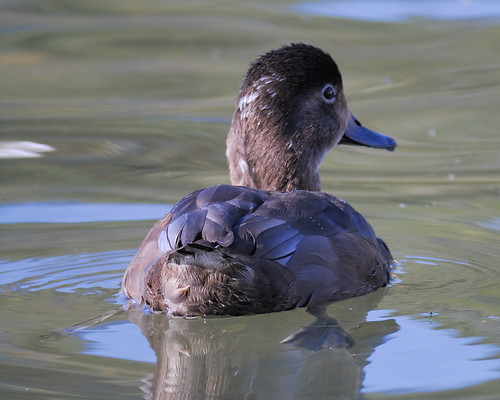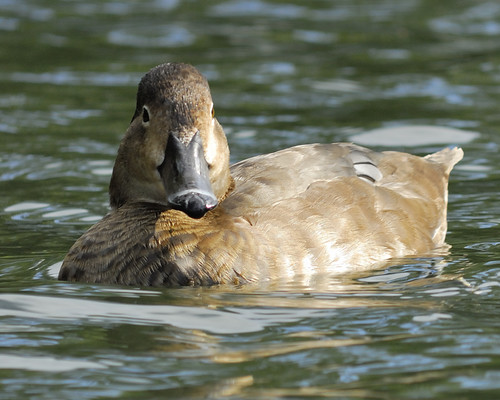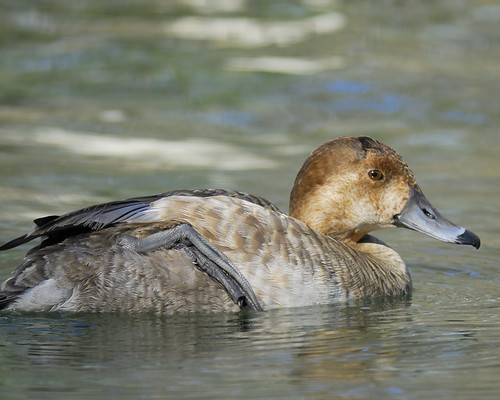tags: birds, mystery bird, bird ID quiz
[Mystery bird #1] Ring-necked Duck, Aythya collaris, photographed at the Hermann Park Conservancy, Houston, Texas. [I will identify this bird for you in 48 hours]
Image: Joseph Kennedy, 18 November 2009 [larger view].
Nikon D200, Kowa 883 telescope with TSN-PZ camera eyepiece 1/640s f/8.0 at 1000.0mm iso400.
Please name at least one field mark that supports your identification.
[NOTE: all IDs were made by the photographer; I don't agree with them, but I am reporting them. Of course, the links to the original images are broken now]
Mystery bird #2:
[Mystery bird #2] Ring-necked Duck, Aythya collaris, photographed at the Hermann Park Conservancy, Houston, Texas. [I will identify this bird for you in 48 hours]
Image: Joseph Kennedy, 16 November 2008 [larger view].
Nikon D200, Kowa 883 telescope with TSN-PZ camera eyepiece 1/250s f/1.0 iso400.
Mystery bird #3:
[Mystery bird #3] Redhead, Aytha americana, photographed at the Hermann Park Conservancy, Houston, Texas. [I will identify this bird for you in 48 hours]
Image: Joseph Kennedy, 5 December 2009 [larger view].
Nikon D200, Kowa 883 telescope with TSN-PZ camera eyepiece 1/500s f/8.0 at 1000.0mm iso400.
Mystery bird #4:
[Mystery bird #4] Redhead, Aytha americana, photographed at the Hermann Park Conservancy, Houston, Texas. [I will identify this bird for you in 48 hours]
Image: Joseph Kennedy, 21 November 2007 [larger view].
Nikon D200, Kowa 883 telescope with TSN-PZ camera eyepiece 1/180s f/8.0 at 1000.0mm iso400.
Mystery bird #5:
[Mystery bird #5] Ring-necked Duck, Aythya collaris, photographed at the Hermann Park Conservancy, Houston, Texas. [I will identify this bird for you in 48 hours]
Image: Joseph Kennedy, 5 December 2009 [larger view].
Nikon D200, Kowa 883 telescope with TSN-PZ camera eyepiece 1/640s f/8.0 at 1000.0mm iso400.
Mystery bird #6:
[Mystery bird #6] Redhead, Aytha americana, photographed at the Hermann Park Conservancy, Houston, Texas. [I will identify this bird for you in 48 hours]
Image: Joseph Kennedy, 5 December 2009 [larger view].
Nikon D200, Kowa 883 telescope with TSN-PZ camera eyepiece 1/500s f/8.0 at 1000.0mm iso400.
Mystery bird #7:
[Mystery bird #7] Ring-necked Duck, Aythya collaris, photographed at the Hermann Park Conservancy, Houston, Texas. [I will identify this bird for you in 48 hours]
Image: Joseph Kennedy, 16 November 2008 [larger view].
Nikon D200, Kowa 883 telescope with TSN-PZ camera eyepiece 1/350s f/1.0 iso400.
Mystery bird #8:
[Mystery bird #8] Redhead, Aytha americana, photographed at the Hermann Park Conservancy, Houston, Texas. [I will identify this bird for you in 48 hours]
Image: Joseph Kennedy, 13 January 2008 [larger view].
Nikon D200, Kowa 883 telescope with TSN-PZ camera eyepiece 1/500s f/8.0 at 1000.0mm iso400.









Blue-gray bill, round head, warm brown.
I think we have seen another one of these here recently.
That was for #1.
Heh. As Steve Martin said in Roxane, "The good Lord giveth, and he just kept on givin'!"
I'll have to take a look at these when I've got some more time tonight. Fun little challenge, though.
What's happening here!!! I think 1-7 are identifiable but #8 is something else, I think.
Well, they clearly are not squirrels, so I vote for cactus.
Adrian, I've just checked over the entire genus. Unless #8 is a hybrid of some sort, it's the same as the first 7.
I only see two things that make me wonder about it. The first is a complete lack of an eye-ring. The other is that the forehead seems too low, going into the bill too smoothly.
The body appears odd because the bird is rolled over on one side, and we're looking mostly at the underside. (Which rules out several members of the genus, actually).
Hi, I thought the eye colour of #8 was too reddish for the other 7. I was also thinking a hybrid as Aythya ducks are notorious for this, I suspect Redhead x Canvasback. If it was the UK I would have said Pochard x Scaup or Tufted.
It's quite funny sat here getting the inside knowledge (and also getting the snacks whilst Grrl writes a blog post for your entertainmentchecks her email). I think she'd like to see how you are deciding between the 2 or three alternatives.
She also wants cacti down to species level.
Finally home- I have to say that I remain unconvinced at the outcome of our last outing on the Redhead/Ring-necked debate and I am applying same considerations I used last time...
so therefore:
a female Ring-necked Duck for #2 through 7, with #2/7 being the same individual, and #3/5/6 being a second individual...
#1 appears to fit my expectation for a female Redhead and I agree that #8 is a little problematic, certainly mostly Redhead, so if a hybrid I'm going to say a second generation Redhead hybrid (i.e. mom was all Redhead while dad was half and half)
Looks to me like Redheads #1-7, and maybe a Redhead X Canvasback (?) for #8.
The first seven birds are all too warm brown in the face and too pale on the back to be Ring-necked Ducks. None of them show the peaked head shape of a Ring-necked. Most of them also clearly show a paler base to the bill, typical of Redhead. Ring-necked females have a darker base to the bill, approaching the shade of the tip. For several of these birds, the lighting seems to make this mark harder to use, but since none of them shows the colder, grayer, more contrasty look of a Ring-necked, I'm not worried by it.
Scaup would show a darker head, usually with distinct white spot at the base of the bill, and a different bill pattern. Canvasback would show a very sloping forehead and an all dark bill.
Re. the rest of the genus (with ducks, it's never a bad idea to look farther afield for a weird one, since so many species manage to escape captivity.) Pochard should be the closest -- but the bill should show a dark base very similar in color to the tip, with a fairly broad, pale gray band across the middle. The head is typically slightly peaked as well. Southern and Red-crested Pochards should show bright, strongly contrasting white patches on the face. Tufted Duck should have a much darker head with a distinct peak at the rear and a darker back. Apparently the iris is usually yellow in adult females, but it does appear to vary, at least with age. All of the other members of the genus should have very dark heads.
Yes, I think 1-7 are Redheads, possibly 2 individuals, I can't see any features I would expect on female Ring-necked on these. Hybrid Aythyas are difficult to pin down to parentage and I can't find any info on the frequency of hybrids in the US in this group. A second generation would explain features of #8 though David.
As I showed Grrl last time, the group consensus and Grrl named tha last one a Redheaded thinking that was what the photographer confirmed but the same individual duck was photographed four times more and named a Ringneck by Joseph Kennedy, then his original Ringneck was changed to a Redheaded after this blog.
For me this is like the flycatcher, I get as far as either Redheaded or Ringneck or maybe even Scaup.
I just went back and checked the link Maggie put in, and thought I should point something out. The use of Pochard as an alternate for Redhead is definitely not a standard use. The name Pochard is sometimes applied to the genus as a whole, but it also applies specifically to Aythya ferina.
psweet: did you check out the 4 links I provided at comment# 16?
Hi Paul and Adrian,
I understand the argument for why some of the above (perhaps all) could be considered Redhead but by the same token, many of the descriptions I have reviewed would support Ring-necked, however I am beginning to suspect that part of the problem here is that we may be seeing juveniles and some of the subtle differences we see between what a female of a given species should look like and what is manifested in the photos is perhaps that difference- in some photos of juvenile Ring-necked Ducks I am seeing a consistent reduced light area at the base of the bill, or none at all, so if that is one of the differentiating criteria being used, it may not be as reliable as something like throat color or breast/belly color changes, etc.
Any thoughts?
Hello David,
If I have done this link correctly (my record on this is not good) there should be some pics of an immature R-n Duck.
I don't think they look like any of the MB pics.
www.gobirding.eu/Photos/RingneckedDuck.php ( for some reason I cannot link to this site properly---again)
Maggie -- I just checked the four links -- I'm not sure if they're all the same bird, but I have no problem calling them all Redheads. (I have the same problem with skippers -- I was working on a video project with them this fall, went through all my clips, and found that the 4 or 5 that I called Little Glassywings were all in fact something else.)
David, I'm not really using the pale feathering behind the bill - that seems to be highly variable in both species. An age-related aspect to that makes sense, although it helps to have known-aged birds to work on. I'm working mostly on color (warm red-brown compared to cool gray-brown), head shape, back color (especially the shoulder area) and the color of the proximal portion of the bill.
Probably Macropus rufus but an outside chance it's Mycoplasma pneumoniae. I'm not enough of an expert to tell them apart.
Thanks Paul... with reference to the slighly elongated head of #8, any chance there might be some Canvasback (Aythya valisineria) in there?
Hi, David, yeah, Canvasback would be my first guess. Of course, sometimes hybrids in this group end up looking like something else entirely.